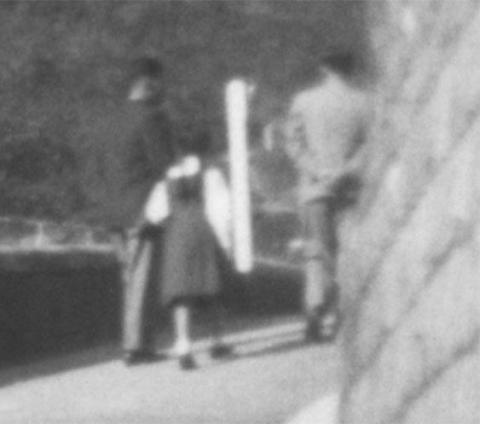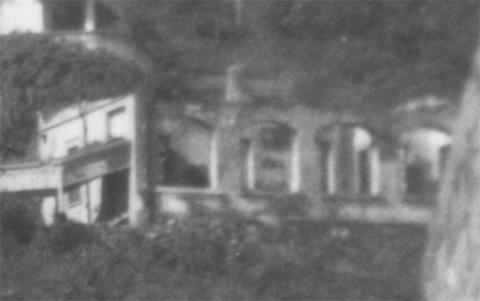Where: This view isn't difficult to locate, as though over 60 years have passed, the road in the foreground looks much the same today. (E-mail subscribers, please click to view the web version of this page so you can see the modern view below.)
Who: Today the road is a popular family walk, leading down from the Peak to the reservoir at Pok Fu Lam. Most people walk the road in daytime, but if you choose a dry, dark evening after sunset in summer, you'll likely be rewarded by seeing fire flies in the bushes along the way.
The downhill direction is obviously the easier way to go, but the family in this photo have chosen the more strenuous uphill climb. The men are wearing jackets, so hopefully it was a cool day.
What: The "ruins" in the title both have a link to men in uniform. Army first - they were the residents of the building on the left for many years. It is the ruined east wing of the old Mount Austin Barracks. It was originally built as a hotel, but that went out of business in less than a decade. The British Army stepped in, buying it in 1897 and converting it to barracks for their soldiers.
On the right of the photo is another ruin. It's a smaller building, but one with an even longer history.
It was built in 1869 as the No. 6 police station, the first and only police station on the Peak until 1886, when a second, larger station was built at Mount Gough.
The old No. 6 station was then used as quarters for single men for a while, before being abandoned in the 1930s.
In contrast to the ruins, the building between them looks very bright and clean. It's a residential building called Chu Wan, and is the only one of the three buildings that still stands today.
When: Pinning down the exact year the photo was taken is tricky based on these buildings.
The barracks might help as they were damaged during the fighting in 1941. However a photo taken just after the war shows the east wing still had its roof, unlike the roofless ruin shown above. So maybe this photo was taken after 1947, when a local newspaper announced that "Part of the east wing of Mount Austin barracks is being pulled down tomorrow because of its dangerous condition, ...".
The white Chu Wan building is a better guide to the earliest date the photo was taken. It was built in 1948, so the photo can't have been taken before that.
Then if you've read Martin Booth's book about his childhood in Hong Kong (named either "Gweilo" or "Golden Boy", depending on the edition), you'll know he was living at Mount Austin Mansions in 1953, as he describes seeing the great fire at Shek Kip Mei from there. The Mansions were built on the site of the old Mount Austin Barracks, so the photo must have been taken before 1953.
That only narrows down the range to 1948-1953, or 1948-1952 if we allow time to build the new Mount Austin Mansions. Thankfully, whoever was the photographer had the wonderful habit of writing notes on the back of their photos, so the answer is as simple as turning the photo over.
It was taken less than two years before Booth's family moved in to Mount Austin Mansions, so I wonder if the barracks were being demolished when this photo was taken, in preparation to start building the mansions?
As always, comments and corrections are welcome, as well as any memories of this area. Please leave your messages in the comments below.
Gwulo photo ID: A416
Further reading:
- The three police stations in the Peak district: #6 Police Station, Peak Police Station at Mount Gough, and Wan Chai Gap Police Station above Coombe Road.
- We've also got a map of all the police stations which have pages the Gwulo website.
- A companion guide to Martin Booth's book, Gweilo / Golden Boy, with links to photos and other information for each of the main places he mentions.
- Historic sites to see along the walk to Pok Fu Lam reservoir, shown on a 1952 map of the area.
- And if you'd like to see more old Hong Kong photos & stories, you can download free chapters of the Gwulo book: Old Hong Kong Photos and The Tales They Tell.






Comments
When I lived on the Peak on
When I lived on the Peak on Lugard Rd in the late 1960s every single Sunday you had many families walking round the peak. The men would still have their jackets on. In this heat? I would ask. My mother would answer. It’s easier than carrying it.
Anther hoto showing wartime
Another photo showing wartime damage to the barracks:
Re: Chu Wan
Hi David,
I was recently on the Peak area and the present day Chu Wan does not look exactly like the one in the photo above. I suspect it had been extended and heavily remodelled over the years.
The house looked bigger, and the colours on the exterior look fresh.
T